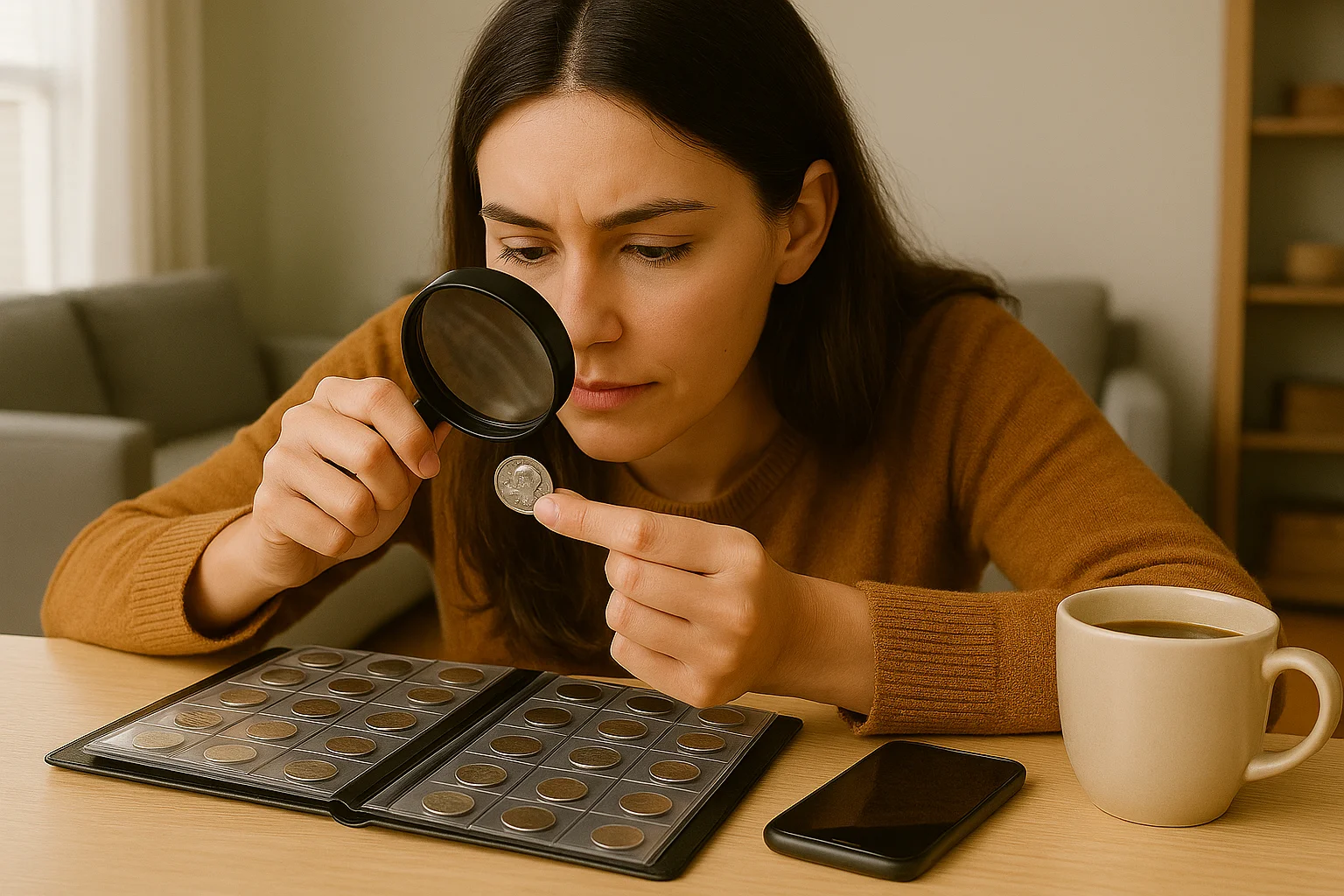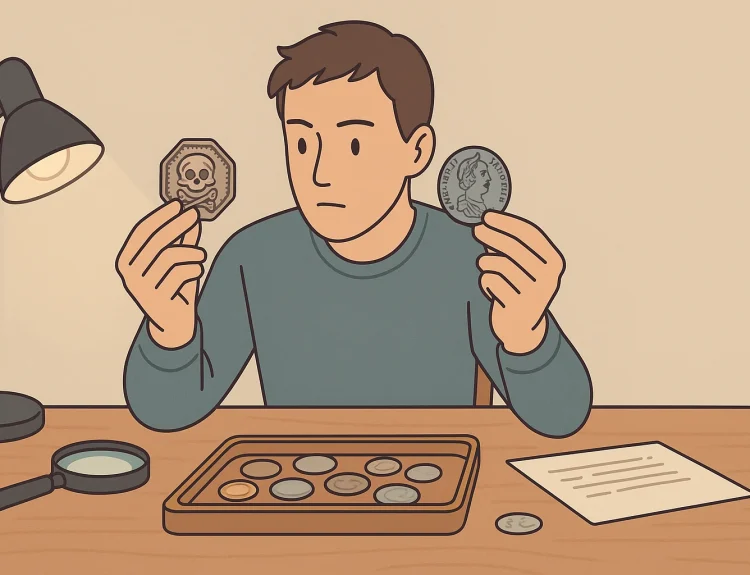When most people think of American coins, they picture the penny or the quarter. But the humble dime — just ten cents in face value — also carried some of the most fascinating designs in U.S. coin history. Lightweight, often overlooked, and easy to pass over in daily change, the dime actually offers a rich timeline of American ideals, art, and politics pressed into metal.
One of the most common questions new collectors ask is who is on the dime. The answer isn’t as straightforward as it might seem. While today’s dime features President Franklin D. Roosevelt, but this wasn’t always the case. Over the last two centuries, the dime featured various representations.
So, today we are here to get through all the nuances and each major type of dime ever minted in the United States. From rare Draped Bust issues to modern Roosevelt dimes, this is your go-to material for understanding every face that’s ever graced America’s ten-cent coin.

Draped Bust Dime (1796–1807): The First American Ten-Center
The Draped Bust dime is where it all began. Introduced in 1796, this was the very first ten-cent piece minted in the U.S., four years after the U.S. Mint started producing coins. Its obverse featured a flowing-haired Liberty — a symbolic personification of freedom rather than a real individual — facing right, surrounded by stars representing the states.
These coins are extremely rare and valuable, especially the 1796 version with just 13 stars, as opposed to the 16 stars added later that same year. That is why many counterfeits exist, especially of the rare 1796 issues. So, if you are lucky enough to find something similar to this coin, start with paying close attention to the edge reeding and the alignment of the date — forgeries often get these wrong.
Draped Bust Dime Characteristics
| Feature | Details |
| Years Minted | 1796–1797, 1798–1807 (not struck every year) |
| Obverse Design | Liberty with flowing hair (symbolic figure) |
| Reverse Design | Small eagle (1796–97), heraldic eagle (1798–1807) |
| Metal Content | 89.24% silver, 10.76% copper |
| Diameter | ~19 mm |
| Designer | Robert Scot |
| Mints | Philadelphia only |
In 1796, only 22,135 Draped Bust dimes were minted — the lowest original mintage of any dime series. These coins were struck without a standardized collar, meaning the edges were manually adjusted, resulting in slight size and shape variations between pieces. This makes authenticating originals more complex — and more fascinating — for collectors today.
Capped Bust Dime (1809–1837): Liberty in a Revolutionary Cap
After a brief pause in dime production, the U.S. Mint introduced a new design in 1809 that reflected the bold, independent spirit of early America. Liberty now appeared in profile wearing a Phrygian cap (a classic symbol of freedom going back to Roman times and often associated with revolution). Her image was framed by stars and accompanied by a more robust eagle on the reverse.
This series was notable for introducing something simple but essential: the “10C” denomination, finally printed on the coin. Earlier dimes lacked a clear denomination, which sometimes caused confusion in circulation.
Tip for Collectors: Watch for year varieties with large and small date numerals — especially 1828 and 1832. These subtle differences can significantly affect value.
Capped Bust dimes were hand-fed into presses, meaning weak strikes and off-center coins are relatively common — not always a flaw, but sometimes a historical charm.
Capped Bust Dime Characteristics
| Feature | Details |
| Years Minted | 1809–1837 |
| Obverse Design | Liberty with a Phrygian “freedom” cap |
| Reverse Design | Eagle with shield, olive branch, arrows, “10C” |
| Metal Content | 89.24% silver → 90% silver (starting 1837) |
| Diameter | ~18.5 mm |
| Designer | John Reich (early issues), William Kneass |
| Mints | Philadelphia only |
In total, 123 different date-and-variety combinations exist within the Capped Bust dime series — making it one of the most complex types for specialists. In 1828, a new closed-collar minting method was introduced, and it helped standardize diameter and improve strike consistency. That’s why 1828 is often seen as a transitional year between “old-school” and modern minting.
Seated Liberty Dime (1837–1891): A Nation Matures
The Seated Liberty design reflected a more established vision of America. Liberty is now shown seated on a rock, holding a liberty pole and shield — symbolizing both vigilance and peace. This series ran for over 50 years, which makes it one of the longest-running designs in U.S. coinage history.
What makes this era particularly interesting is the evolution within the series: stars were added, mottoes changed, and tiny design tweaks made for a collector’s dream.
Interestingly, in 1853, arrows were added beside the date to indicate a reduction in silver content — a tiny detail with huge significance.
Seated Liberty Dime Characteristics
| Feature | Details |
| Years Minted | 1837–1891 |
| Obverse Design | Liberty seated with shield and pole |
| Reverse Design | Wreath (early), legend variations over time |
| Metal Content | 90% silver, 10% copper |
| Diameter | ~17.9 mm |
| Designers | Christian Gobrecht |
| Mints | Philadelphia, New Orleans, San Francisco, Carson City |
Despite its long run, the Seated Liberty dime saw several mint closures, including the New Orleans Mint in 1861 due to the Civil War, making coins from certain mints and years (like the rare 1870-CC issue) notably scarce and sought after by collectors today.
Barber Dime (1892–1916): A Plain Face with Hidden Rarities
Named after its designer, Charles E. Barber, the Barber Dime marked a shift in coin aesthetics because of its simplicity and formality. Replacing the more intricate Seated Liberty design, this dime features the head of Liberty in profile, wearing a Phrygian cap and a laurel wreath — a nod to classical ideals, though rendered in a much more straightforward, almost conservative style.
While the design isn’t everyone’s favorite — some collectors even call it dull compared to the flowing lines of the Mercury Dime or the symbolism of earlier coins — the Barber series is full of concealed nuances. Most circulated heavily and were used in everyday life for decades, which means that well-preserved examples are far harder to come by than you’d expect.
One of the most famous and valuable U.S. coins of all time is a Barber Dime: the 1894-S. Only 24 were ever minted, reportedly for a group of bankers and dignitaries, and fewer than 10 are known to exist today. One of these even surfaced in a child’s lunch money jar decades later — a reminder that treasure might be hiding in the most ordinary places.
Barber Dime Characteristics
| Feature | Details |
| Years Minted | 1892–1916 |
| Obverse Design | Liberty in profile with laurel wreath and cap |
| Reverse Design | “ONE DIME” within a wreath |
| Metal Content | 90% silver, 10% copper |
| Diameter | ~17.9 mm |
| Designer | Charles E. Barber |
| Mints | Philadelphia, New Orleans, Denver, San Francisco |
Tip for Collectors: Most Barber Dimes you’ll encounter will be worn down, especially around Liberty’s headband and the reverse wreath. If you spot one with clear details, you’re already ahead of the game. And be sure to look at the mint mark (below the wreath on the reverse) — coins from New Orleans (“O”) or San Francisco (“S”) in certain years are especially desirable.
Mercury Dime (1916–1945): Liberty Takes Flight
Elegant, artistic, and packed with symbolism, the Mercury Dime is arguably the most beloved U.S. dime among collectors. Despite its name, it doesn’t actually depict the Roman god Mercury. Instead, the obverse shows Liberty wearing a winged cap, meant to symbolize freedom of thought. The confusion came from the resemblance to Mercury’s traditional winged helmet — and the nickname stuck.
The series includes one of the most famous key dates in U.S. coinage: the 1916-D Mercury Dime. With just 264,000 struck, it’s a true rarity, and well-preserved examples fetch thousands of dollars. Always check for the “D” mint mark on the reverse, to the left of the base of the fasces.
Tip for Collectors: Mercury Dimes are still surprisingly affordable in circulated grades, especially later dates. Look for full “bands” on the fasces — sharp, distinct horizontal lines that indicate a strong strike and raise the coin’s value significantly.
Mercury Dime Characteristics
| Feature | Details |
| Years Minted | 1916–1945 |
| Obverse Design | Liberty in winged cap (often mistaken for Mercury) |
| Reverse Design | Fasces with olive branch |
| Metal Content | 90% silver, 10% copper |
| Diameter | ~17.9 mm |
| Designer | Adolph A. Weinman |
| Mints | Philadelphia, Denver, San Francisco |
Pro Tip: Use apps like Coin ID Scanner to quickly verify a Mercury Dime’s coin details, date, mint mark, and estimated market value. It is especially helpful when checking for high-value examples like the 1916-D or Full Band strikes.
Roosevelt Dime (1946–Present): A Modern Classic with Hidden Value
After the death of President Franklin D. Roosevelt in 1945, the U.S. Mint made a quick decision: the next dime would bear his image. It wasn’t just about honoring a wartime leader — Roosevelt was also the public face of the fight against polio and a major supporter of the March of Dimes campaign. So, in 1946, a new design debuted, featuring Roosevelt’s profile on the obverse and a torch flanked by an olive branch and an oak branch on the reverse, symbolizing liberty, peace, and strength.
At first glance, the Roosevelt Dime might seem like just another modern coin — after all, it’s still being minted today. But dig a little deeper, and you’ll find an interesting shift in materials, surprising rarities, and collectible value even in something as ordinary as a pocketful of change.
From 1946 to 1964, Roosevelt Dimes were struck in 90% silver. These are the ones collectors really watch for, because their silver content alone gives them intrinsic value — often more than their face value. Starting in 1965, the composition changed to a copper-nickel clad, and silver was removed entirely from circulation dimes. However, proof and special collector sets sometimes continued to include silver versions, especially in later years.
Roosevelt Dime Characteristics
| Feature | Details |
| Years Minted | 1946–present |
| Obverse Design | President Franklin D. Roosevelt |
| Reverse Design | Torch, olive branch (peace), oak branch (strength) |
| Metal Content | 90% silver (1946–1964), clad copper-nickel (1965–present) |
| Diameter | ~17.9 mm |
| Designer | John R. Sinnock |
| Mints | Philadelphia, Denver, San Francisco |
A fun twist? There are No-S Proof Roosevelt Dimes — ultra-rare examples mistakenly struck at the San Francisco Mint without the “S” mint mark. Look out for these rarities in proof sets from 1968, 1970, 1975, and 1983. These can be worth hundreds, even thousands, of dollars.

Collecting Dimes: Tips for Beginners
Getting started with dime collecting doesn’t require a big budget or a deep numismatic background. In fact, you can build a solid and satisfying collection by following a few smart steps:
1. Start with Roosevelt Dimes. They’re easy to find in circulation and coin shops. Focus on those minted before 1965, as they contain 90% silver and tend to hold value beyond their face amount.
2. Work your way back. Once you’ve gathered some Roosevelt Dimes, try expanding your collection to Mercury Dimes and Barber Dimes. These older coins are rich in history and design, though they may be more worn or harder to find.
3. Store your coins properly. Silver tarnishes over time, so keep your dimes in coin capsules, flips, or acid-free albums. This helps protect their condition and long-term value.
4. Pay attention to details. Rarity isn’t always about age — sometimes it’s in the small things. Watch for mint marks, date varieties, strike quality, and design quirks. A sharp eye can turn a common coin into a special find.
5. Use digital tools to your advantage. Apps like Coin ID Scanner can scan and identify your coins in seconds. They’ll help you verify mint marks, check for historical background and nuances, and see current market values — making your collecting smarter and faster.
Dime collecting is a journey, not a race. If you’re saving coins from change or hunting for rarities, each piece adds a little more history to your collection — and a little more fun to the process.
Small Coin, Big History
The dime might be small, but it’s packed with stories. Each version of the piece — from Liberty in classical poses to a president who inspired a generation — tells part of the American journey.
So, who’s on the dime? The answer depends on when it was minted — and that is one of the things which makes dime collecting so fascinating. Start with a coin from your change jar. You never know — you might be holding a tiny piece of history worth far more than ten cents.




